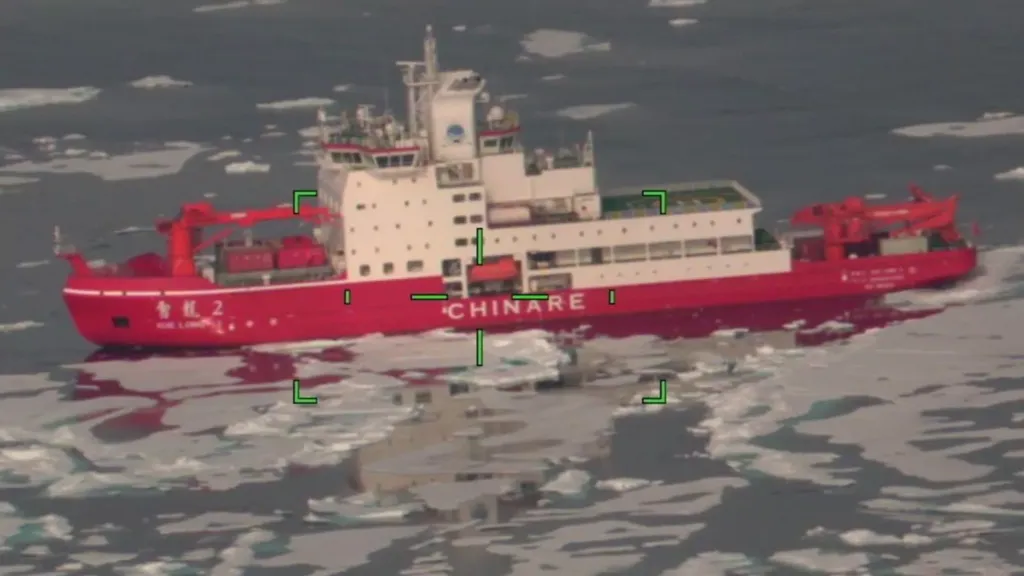A new Newsweek map tracks a Chinese research vessel that was operating deep in the Arctic, north of Alaska, when it was intercepted by a United States Coast Guard aircraft last week.
The Chinese ship Xue Long 2 -- an icebreaker designed for operations in polar regions -- was previously monitored by the Canadian military as it entered Arctic waters from East Asia.
Newsweek has contacted the Chinese defense and foreign ministries for comment via email.
China asserts itself as a "near-Arctic state" and an important stakeholder in Arctic affairs. It has steadily expanded its presence in the region -- which is surrounded by NATO members and Russia -- by deploying ships and conducting research, some of which may have military applications.
The U.S. has been alarmed by China's presence in the Arctic -- including its cooperation with Russia -- and the Pentagon, in an updated Arctic strategy, calls for an increased military presence, enhanced intelligence capabilities and greater cooperation with America's allies to address Chinese activity.
A U.S. Coast Guard C-130J aircraft "detected and responded" to the Xue Long 2's presence on the U.S. Extended Continental Shelf (ECS) in the Arctic -- approximately 333 miles north of Utqiagvik, Alaska, the U.S.' northernmost community -- on Friday, the Coast Guard revealed.
The ECS -- which the Coast Guard stated in a Saturday press release the U.S. has exclusive rights to "conserve and manage the living and non-living resources" within -- refers to the portion of the continental shelf extending beyond 230 miles from the country's coastline.
The United Nations Convention on the Law of the Sea (UNCLOS) defines the continental shelf as the submarine areas extending beyond the territorial sea of a coastal state, following "the natural prolongation of its land territory to the outer edge of the continental margin."
In comparison, U.S. territorial waters and exclusive economic zones extend up to 13.8 miles and 230 miles from the country's coastline, respectively, according to UNCLOS. The Xue Long 2 was detected operating 149 miles inside the ECS boundary, the Coast Guard said.
The Coast Guard aircraft was deployed as part of Operation Frontier Sentinel, a mission aimed at meeting presence with presence in response to adversary activity in or near Alaskan waters. A Coast Guard vessel also recently patrolled the Bering Sea off the coast of Alaska.
According to the U.S. State Department, the U.S. has ECS claims in the Arctic, Atlantic waters off the East Coast, the Bering Sea, Pacific waters off the West Coast, the Mariana Islands, and two areas in the Gulf of America -- also known as the Gulf of Mexico.
Rear Admiral Bob Little, commander of the U.S. Coast Guard Arctic District, said in a press release on Saturday: "The U.S. Coast Guard, alongside partners and other agencies, vigilantly monitors and responds to foreign government vessel activity in and near U.S. waters to secure territorial integrity and defend sovereign interests against malign state activity."
The U.S. State Department said of the U.S. Extended Continental Shelf Project: "All coastal States with an ECS have an inherent interest in knowing, and declaring to others, the outer limits of their ECS and thus where they are entitled to exercise sovereign rights. Defining the U.S. ECS outer limits in geographical terms provides the specificity and certainty necessary to manage the resources of the ECS."
Details of the Xue Long 2's mission in the Arctic remain unclear. The U.S. and Canada are expected to continue monitoring the Chinese ship as it operates in waters off their coastlines.
